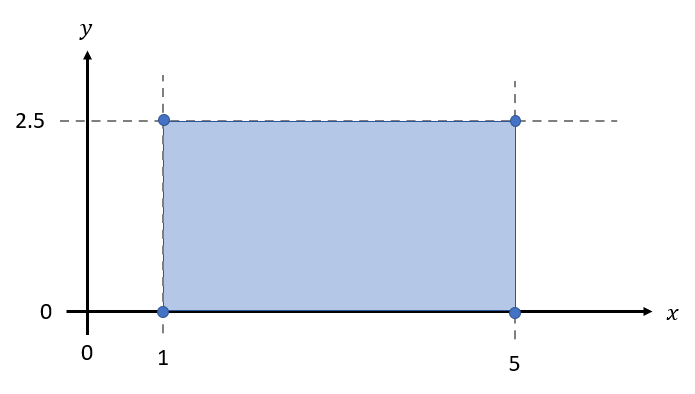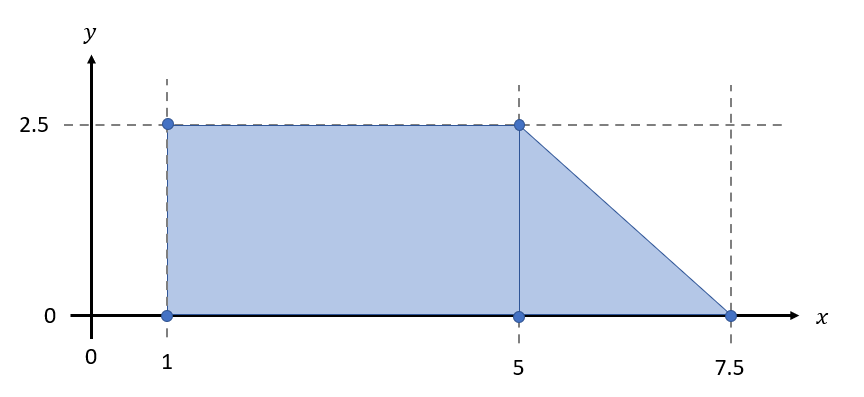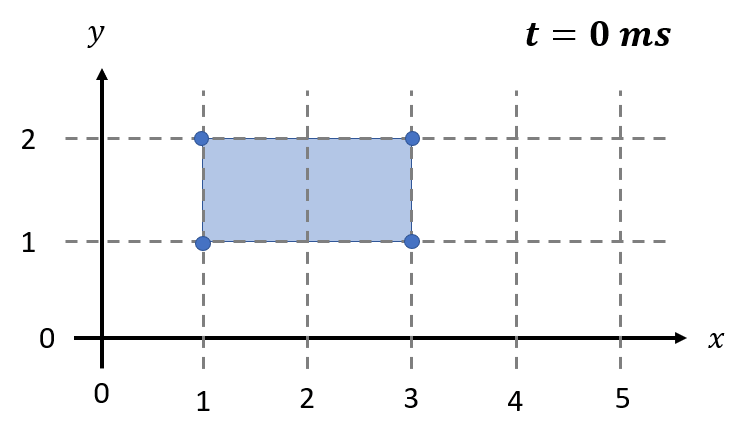Polygon Series file
Multics “polygon files” are used to store data about a set of polygons whose vertices may change position over time.
Definitions
Polygon
As discussed by Wolfram MathWorld, there is no universally-accepted definition of a polygon. The definition that Multics uses is a combination of elements of different definitions of a polygon from multiple sources.
In general terms, Multics defines a polygon as a closed, two-dimensional (2D) region bounded by a series of connected line segments that may or may not not intersect themselves.
Put another way, a polygon can be considered the closed 2D region bounded by line segments connecting a cyclical series of points in order, where the boundary never intersects itself.
Point-in-Polygon Problem
A point-in-polygon problem is a geometric problem attempting to determine whether a given point is inside or outside a (possibly self-intersection) polygon.
There are a number of algorithms that have been proposed for solving the point-in-polygon problem. The Multics software uses the winding number algorithm.
For more detail on the point-in-polygon and winding number algorithm, refer to this paper.
File Format
A polygon file stores the \(x\)- and \(y\)-coordinates of one or more polygons, at one or more instants in time. The purpose of the file is to store whether a point is “inside” the polygon(s) at a specific point in time. In the event there are multiple polygons, there are several options for specifying how to define “inside,” as will be discussed below.
Warning
As explained below, the term “time” is used loosely with polygon files. The
measure of time does not necessarily need to be “physical time” (i.e.,
measured in seconds). Rather, it could be “time” measured as, for example,
the rotation angle of a pump shaft (in which case [TIME_UNIT] might be
degrees).
General Format
There are two primary parts of a polygon file: (1) the header and (2) the polygon coordinates. The header lines in the files below are highlighted to distinguish the two parts of the file.
The standard format of a full polygon file is shown below. It can seem confusing at first, so if you aren’t sure about the format, skip to the later sections in which the format is broken down in more detail. The format is slightly different if storing one instant in time or multiple instants, and each is described under the tabs below.
11 [Np] [POLYGON_MERGE_METHOD]
2[NUM_COORD_1] [IS_INSIDE_1] # <-- polygon 1
3[X_COORDINATE_UNIT]: [X_1] [X_2] ... [X_{NUM_COORD_1}]
4[Y_COORDINATE_UNIT]: [Y_1] [Y_2] ... [Y_{NUM_COORD_1}]
5[NUM_COORD_2] [IS_INSIDE_2] # <-- polygon 2
6[X_COORDINATE_UNIT]: [X_1] [X_2] ... [X_{NUM_COORD_2}]
7[Y_COORDINATE_UNIT]: [Y_1] [Y_2] ... [Y_{NUM_COORD_2}]
8...
9[NUM_COORD_j] [IS_INSIDE_j] # <-- polygon j
10[X_COORDINATE_UNIT]: [X_1] [X_2] ... [X_{NUM_COORD_j}]
11[Y_COORDINATE_UNIT]: [Y_1] [Y_2] ... [Y_{NUM_COORD_j}]
12...
13[NUM_COORD_Np] [IS_INSIDE_Np] # <-- polygon NUM_POLYGONS
14[X_COORDINATE_UNIT]: [X_1] [X_2] ... [X_{NUM_COORD_Np}]
15[Y_COORDINATE_UNIT]: [Y_1] [Y_2] ... [Y_{NUM_COORD_Np}]
1[Nt] [Np] [POLYGON_MERGE_METHOD]
2[TIME_UNIT]: [TIME_BEGIN] [TIME_STEP] [TIME_EXTRAP_METHOD]
3[NUM_COORD_1_1] [IS_INSIDE_1_1] # <-- time step 1, polygon 1
4[X_COORDINATE_UNIT]: [X_1] [X_2] ... [X_{NUM_COORD_1_1}]
5[Y_COORDINATE_UNIT]: [Y_1] [Y_2] ... [Y_{NUM_COORD_1_1}]
6[NUM_COORD_1_2] [IS_INSIDE_1_2] # <-- time step 1, polygon 2
7[X_COORDINATE_UNIT]: [X_1] [X_2] ... [X_{NUM_COORD_1_2}]
8[Y_COORDINATE_UNIT]: [Y_1] [Y_2] ... [Y_{NUM_COORD_1_2}]
9...
10[NUM_COORD_1_Np] [IS_INSIDE_1_Np] # <-- time step 1, polygon NUM_POLYGONS
11[X_COORDINATE_UNIT]: [X_1] [X_2] ... [X_{NUM_COORD_1_Np}]
12[Y_COORDINATE_UNIT]: [Y_1] [Y_2] ... [Y_{NUM_COORD_1_Np}]
13[NUM_COORD_2_1] [IS_INSIDE_2_1] # <-- time step 2, polygon 1
14[X_COORDINATE_UNIT]: [X_1] [X_2] ... [X_{NUM_COORD_2_1}]
15[Y_COORDINATE_UNIT]: [Y_1] [Y_2] ... [Y_{NUM_COORD_2_1}]
16...
17[NUM_COORD_i_j] [IS_INSIDE_i_j] # <-- time step i, polygon j
18[X_COORDINATE_UNIT]: [X_1] [X_2] ... [X_{NUM_COORD_i_j}]
19[Y_COORDINATE_UNIT]: [Y_1] [Y_2] ... [Y_{NUM_COORD_i_j}]
20...
21[NUM_COORD_Nt_Np] [IS_INSIDE_Nt_Np] # <-- time step NUM_TIME_STEPS, polygon NUM_POLYGONS
22[X_COORDINATE_UNIT]: [X_1] [X_2] ... [X_{NUM_COORD_Nt_Np}]
23[Y_COORDINATE_UNIT]: [Y_1] [Y_2] ... [Y_{NUM_COORD_Nt_Np}]
Note that the numbers on the left-hand side are line numbers, and they are not part of the file.
Section 1: Header
The header contains metadata about the polygon file, formatted as follows:
11 [Np] [POLYGON_MERGE_METHOD]
1[Nt] [Np] [POLYGON_MERGE_METHOD]
2[TIME_UNIT]: [TIME_BEGIN] [TIME_STEP] [TIME_EXTRAP_METHOD]
All parameters must be whitespace-separated.
Header Parameters for All Polygon Files
These parameters should be included in all polygon files.
[Nt]: Number of Time Steps
The number of time steps in the file. Note that for files with a single
time step, Nt must be 1 (as shown in the code block above).
Must be an integer greater than or equal to 1.
[Np]: Number of Polygons per Time Step
The number of polygons per time step in the file, which must be the same for all time steps.
Must be an integer greater than or equal to 1.
Important
Multics requires that the number of polygons is the same for all time steps.
[POLYGON_MERGE_METHOD]: Method for Combining Disjoint Polygons
In the event that there are multiple polygons per time step (i.e., Np > 1),
there are a variety of ways they could be combined. We might want to know
whether a point is inside of all of the specified polygons, or any of
them, as a few examples.
There are three supported options for combining multiple disjoint polygons:
|
Description |
|---|---|
|
If a point is considered “inside” of the union of polygons in the
file if it is inside of any of the |
|
If a point is considered “inside” of the union of polygons in the
file if it is inside of all of the |
|
If a point is considered “inside” of the union of polygons in the
file if it is inside of exactly one of the |
Note that whether a point is inside of each of the Np polygons will
be defined by the IS_INSIDE parameter, discussed in the
Section 2: Polygon Coordinates section.
This parameters is only relevant for polygon files in which Np > 1
but a value should be included in all polygon files (if Np = 1, this
parameter is simply ignored).
Header Parameters for Files with Multiple Time Steps
These parameters should be included only for polygon files multiple time steps (Nt > 1).
[TIME_UNIT]: Time Unit
A string describing the units in which the [TIME_BEGIN] and [TIME_STEP]
parameters are defined.
Note
Recall that Multics uses “time” loosely, and the “time” can also be defined in terms of quantities such as “degrees of rotation of the pump shaft” or similar.
[TIME_BEGIN]: Initial Time
An integer or decimal number specifying the time for the first set of polygons stored in the file.
[TIME_STEP]: Constant Time Step
Type: Floating-point number
Restrictions: Must be a real number greater than 0
An integer or decimal number specifying the time step between each of
the [NUM_POLYGONS] specified polygons.
Important
Multics requires that the time step is constant.
[TIME_EXTRAP_METHOD]: Extrapolation for Time Values
The parameters [NUM_TIME_STEPS], [TIME_BEGIN], and [TIME_STEP]
specify a range of times over which polygons will be provided; let us
denote this range \(t \in [t_{min}, t_{max}]\). This poses an
issue: what should be done if the time \(t\) falls outside this range?
It is not straightforward to “interpolate” or “extrapolate” polygons, since they can have an arbitrary number of coordinates that change in arbitrary ways each time step. Therefore, if \(t\) falls outside \([t_{min}, t_{max}]\), it must be “rescaled” to fall in this range.
Two options are provided for this “rescaling,” described below:
|
Description |
|---|---|
0 or 2 (saturation) |
When reading data from the polygon file, if \(t \lt t_{min}\), it is rescaled by \(t = t_{min}\), and if \(t \gt t_{max}\), it is rescaled by \(t = t_{max}\). |
3 (periodic) |
Assumes that the polygon data are periodic with period
\(t_{min} - t_{max} + \Delta t\), where \(\Delta t\) represents
|
Warning
If using the periodic approximation method (3), notice that you should not include both endpoints in the lookup table (otherwise, the period would be \(t_{max} - t_{min}\), not \(t_{max} - t_{min} + \Delta t\)).
For example, suppose your time variable is a cycle that repeats every rotation (\(360^\circ\)) and you are defining polygons in your polygon file every \(1^\circ\). In this case, your polygon file should include data for the following angles: \(0^\circ, 1^\circ, 2^\circ, ..., 358^\circ, 359^\circ\).
Section 2: Polygon Coordinates
This section contains the \(x\)- and \(y\)-coordinates for all polygons in the file, for every time step. The general structure for specifying these points (for a single polygon) is shown below:
[NUM_COORD] [IS_INSIDE]
[X_COORDINATE_UNIT]: [X_1] [X_2] ... [X_{NUM_COORD}]
[Y_COORDINATE_UNIT]: [Y_1] [Y_2] ... [Y_{NUM_COORD}]
Note that Section 2 of a polygon file typically contains a number of code blocks similar to above. However, each has the same format, so only a single such block will be discussed here. To see how to use multiple such blocks, refer to the Examples section.
The following parameters must be included in this section:
[NUM_COORD]: Number of Points on Polygon Perimeter
The number of \(x\)- and \(y\)-coordinates specifying the polygon perimeter.
Must be an integer greater than or equal to 3.
Note
This information is technically redundant since the coordinates themselves are given. However, it is hard-coded that Multics expects this format, so this number must be provided.
[IS_INSIDE]: How to Define Area “Inside” the Polygon
This input clarifies, for every polygon, what area is considered to be “inside”
the polygon. A polygon encloses a given geometric region, and this area is
typically considered to be “inside” the polygon if IS_INSIDE is set to 1.
However, setting IS_INSIDE to 0 will reverse this convention. The figure
below illustrates these conventions visually.

Note
This value should almost always be 1. It is primarily included in
Multics for backwards compatibility.
[X_COORDINATE_UNIT] and [Y_COORDINATE_UNIT]: Units
These parameters specify the units for the \(x\)- and \(y\)-coordinates specified on the same line as the unit.
[X_1], [Y_1], ..., [X_N], [Y_N]: Perimeter Coordinates
The \(x\)- and \(y\)-coordinates of the polygon perimeter must be
provided on two separate lines. All coordinates should be whitespace-separated,
and there should be a total of NUM_COORD \(x\)-coordinates and
NUM_COORD \(y\)-coordinates.
Examples
Single, Stationary Polygon
Consider perhaps the simplest possible polygon file: a single polygon, at a single time step. Suppose that we want to describe a rectangle with vertices \((1, 0)\), \((5, 0)\), \((5, 2.5)\), \((1, 2.5)\).

In this case, there is one time step (Nt = 1) and a single polygon (Np = 1).
Since there is only one polygon, POLYGON_MERGE_METHOD is not relevant (we’ll
set it to 0 for this example). We’ll assume that all coordinates are in units of
m and that the area enclosed by the rectangle is “inside” the polygon
(IS_INSIDE = 1).
Taken together, these parameters result in the following polygon file:
polygon_file_single_stationary.txt1 1 0
4 1
m: 1 5 5 1
m: 0 0 2.5 2.5
Multiple, Stationary Polygons
Let’s extend the previous example to describe the area inside of a union of two polygons:
A rectangle with vertices \((1, 0)\), \((5, 0)\), \((5, 2.5)\), \((1, 2.5)\)
A triangle with vertices \((5, 0)\), \((5, 2.5)\), \((7.5, 0)\)
Visually, this union is the following pentagon:

In this example, there is one time step (Nt = 1) and two polygons (Np = 2). Since
we want to consider the area enclosed by either of the two polygons as “inside” their
union, POLYGON_MERGE_METHOD should be 0. We’ll assume that all coordinates are in
units of cm and that the area enclosed by both the rectangle and triangle is “inside”
the polygon union (IS_INSIDE = 1).
Taken together, these parameters result in the following polygon file:
polygon_file_multiple_stationary.txt1 2 0
4 1
cm: 1 5 5 1
cm: 0 0 2.5 2.5
3 1
cm: 5 5 7.5
cm: 0 2.5 0
Single, Moving Polygon
Finally, consider a case in which a polygon is moving. This is particularly applicable to fluid power applications, as this may reflect the moving boundary conditions in lubricating films.
As a simple example, consider a rectangular polygon that moves between \(t = 0\ ms\) and \(t = 2\ ms\) as shown below.

Thus, the rectangle has the following vertices at each time step:
\(t\) |
Vertices |
|---|---|
\(0\ ms\) |
\((1, 1)\), \((3, 1)\), \((3, 2)\), \((1, 2)\) |
\(1\ ms\) |
\((2, 1)\), \((4, 1)\), \((4, 2)\), \((2, 2)\) |
\(2\ ms\) |
\((3, 1)\), \((5, 1)\), \((5, 2)\), \((3, 2)\) |
In this case, there are three time steps (Nt = 3) and one polygon (Np = 1).
Since there is only one polygon, POLYGON_MERGE_METHOD is not relevant (we’ll
set it to 0 for this example). The units of time are ms ([TIME_UNITS] = ms),
and since the time begins at zero and advances in \(1\ ms\) increments,
[TIME_BEGIN] = 0 and [TIME_STEP] = 1. Assuming that we want to use
“saturation” for time extrapolation, [TIME_EXTRAP_METHOD] = 0.
Based on the parameters described above and assuming that the coordinates are in
units of ft, these parameters result in the following polygon file:
polygon_file_single_moving.txt3 1 0
ms: 0 1 0
4 1
cm: 1 3 3 1
cm: 1 1 2 2
4 1
cm: 2 4 4 2
cm: 1 1 2 2
4 1
cm: 3 5 5 3
cm: 1 1 2 2
Comments, Whitespace, and Line Endings
Comments should not be used in polygon files.
Items denoted “whitespace-separated” may be separated by either spaces or tab (
\t) characters.Blank lines may be included but are not recommended.
On Linux and MacOS, LF line endings (
\n) must be used. On Windows, either LF (\n) or CRLF (\r\n) line endings may be used.